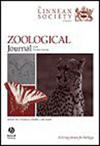Neurocranial anatomy of Paralligator (Neosuchia: Paralligatoridae) from the Upper Cretaceous of Mongolia
IF 3
2区 生物学
Q1 ZOOLOGY
引用次数: 0
Abstract
Neurocranial features appear to be phylogenetically informative and key in assessing the still contentious relationships within Crocodylomorpha. However, the braincases of many non-crocodylian taxa are incompletely studied precluding the assessment of evolutionary modifications at the base of Crocodylia. Here, we describe the braincase osteology and neuroanatomy of the paralligatorid crocodylomorph Paralligator from the Upper Cretaceous of Mongolia based on computed tomography (CT)-scanning, segmentation, and 3D modelling of several specimens. The anatomy of the brain endocast, nerves, and the paratympanic pneumatic cavities of Paralligator is consistent with its phylogenetic position close to or at the base of Eusuchia. Paralligator shares a suit of neuroanatomical features with basal eusuchians and crocodylians reflecting the plesiomorphic condition for Crocodylia. In addition, differences in the brain endocasts between the larger-sized individuals of Paralligator and Kansajsuchus and the smaller Shamosuchus are consistent with ontogenetic changes in extant crocodylians. This suggests that members of the more basal clade Paralligatoridae and the crown-group Crocodylia share similar brain modifications during ontogeny. We also review the distribution of the mesethmoid in Crocodylomorpha and show its presence in several clades including Paralligatoridae and Dyrosauridae.Neurocranial Paralligator解剖(Neosuchia: Paralligatoridae)上白垩纪的蒙古
神经颅特征似乎是系统发育信息和关键评估仍然有争议的关系内鳄。然而,许多非鳄鱼类群的脑壳未被完全研究,排除了对鳄鱼基部进化修饰的评估。在这里,我们描述了脑壳骨学和神经解剖学paralligatorid crocodylomorph Paralligator蒙古上层白垩纪的基于计算机断层扫描(CT)扫描,分割,和3 d造型的几个标本。脑内皮层、神经和副鼓室气腔的解剖结构与它在系统发育上的位置是一致的,它靠近或位于舌足的基部。鳄鱼与基缘目动物和鳄鱼具有相同的神经解剖学特征,反映了鳄鱼的半形神性条件。此外,体型较大的Paralligator和Kansajsuchus个体与体型较小的Shamosuchus个体脑内模的差异与现存鳄鱼的个体发生变化一致。这表明,在个体发育过程中,更基础的鳄鱼科分支和冠类鳄鱼的成员具有相似的大脑发育。我们还回顾了中筛在鳄形目中的分布,并表明它存在于几个分支中,包括平行鳄科和Dyrosauridae。
本文章由计算机程序翻译,如有差异,请以英文原文为准。
求助全文
约1分钟内获得全文
求助全文
来源期刊
CiteScore
6.50
自引率
10.70%
发文量
116
审稿时长
6-12 weeks
期刊介绍:
The Zoological Journal of the Linnean Society publishes papers on systematic and evolutionary zoology and comparative, functional and other studies where relevant to these areas. Studies of extinct as well as living animals are included. Reviews are also published; these may be invited by the Editorial Board, but uninvited reviews may also be considered. The Zoological Journal also has a wide circulation amongst zoologists and although narrowly specialized papers are not excluded, potential authors should bear that readership in mind.

 求助内容:
求助内容: 应助结果提醒方式:
应助结果提醒方式:


